Key takeaways:
- Content prioritization aligns content with audience needs, improving engagement and site performance.
- Factors influencing prioritization include audience behavior, seasonal trends, and alignment with business goals.
- Techniques like a content matrix, the 70-20-10 rule, and regular audits help maintain effective prioritization.
- Utilization of tools like Trello, Google Analytics, and Notion enhances content management and adaptability to trends.
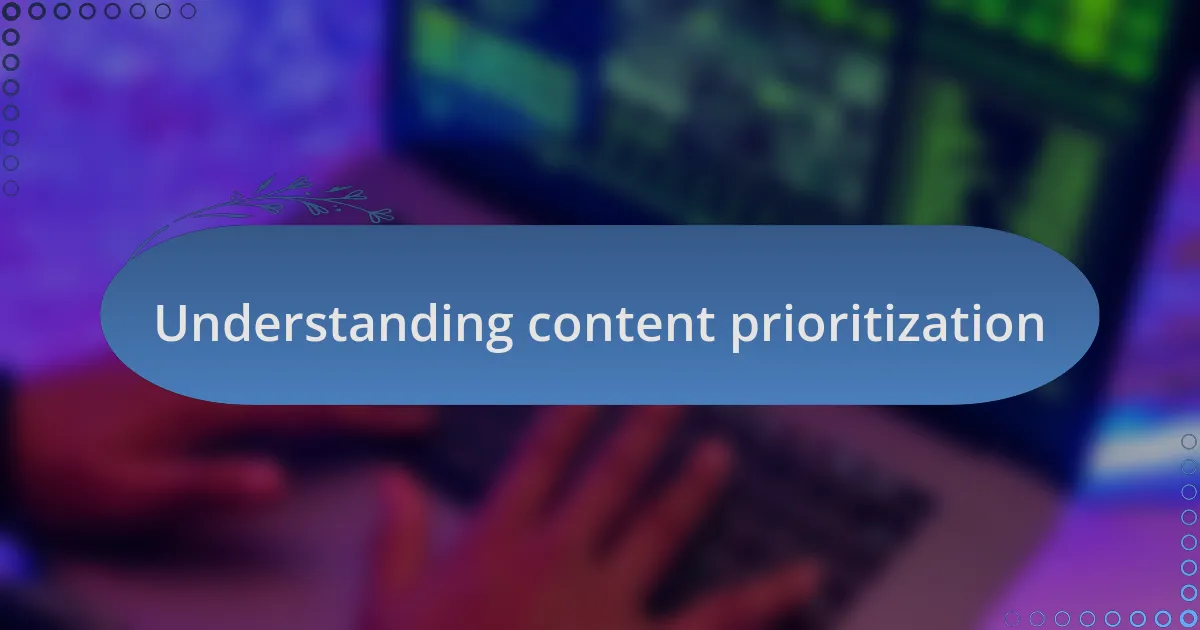
Understanding content prioritization
Content prioritization is more than just figuring out what to publish first; it’s about aligning your content with your audience’s needs. I’ve found that understanding the user journey can significantly influence what content should take precedence. Have you ever wondered how a single piece of content can change a visitor’s experience? It’s crucial to consider what they’re truly searching for and how your content can answer their questions effectively.
Sometimes, I recall instances where I had to decide between two equally compelling articles. I asked myself: which one would genuinely help the reader most right now? This balancing act not only kept my audience engaged but also improved the overall performance of the site. When we prioritize content that resonates deeply with our audience, it feels less like a task and more like a conversation.
In my experience, using analytics to gauge what works can also provide insights into proper prioritization. It’s like having a compass that guides you toward what visitors need most. Have you ever analyzed your site’s data and noticed trends that surprised you? This kind of information can transform your approach, helping you focus efforts where they’ll yield the most impact.
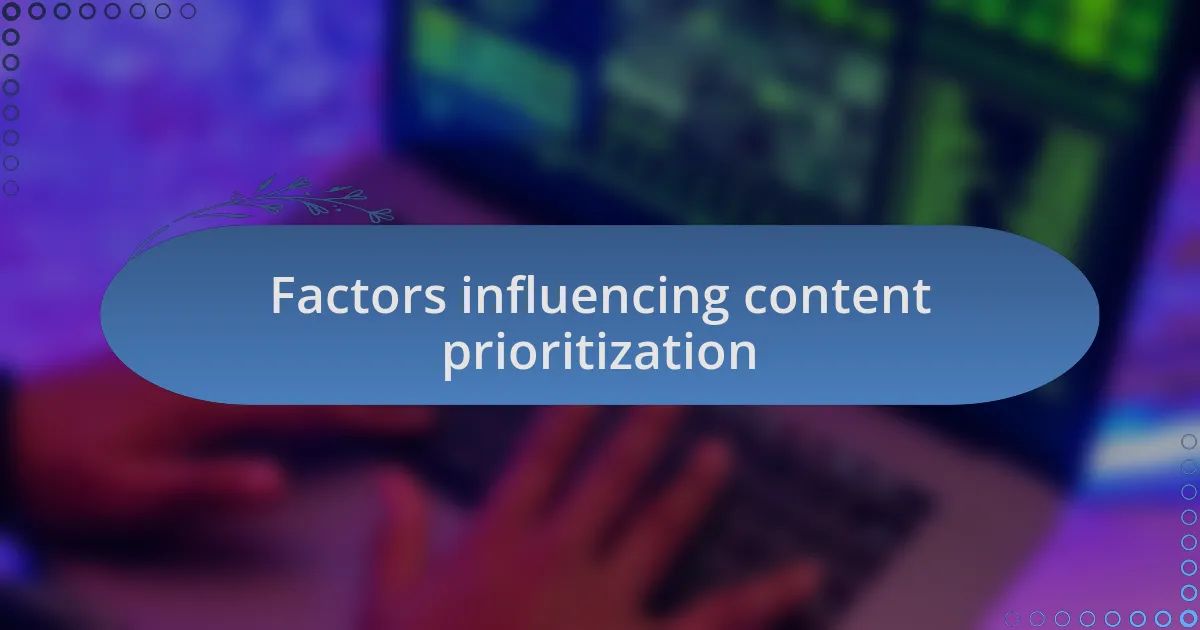
Factors influencing content prioritization
One of the key factors that influence content prioritization is audience behavior. I remember a time when I shifted my focus based on user feedback from surveys and comments. It became clear that certain topics generated more questions and interest than others. This insight not only helped me prioritize those subjects but also deepened my connection with the audience, as it showed that their input mattered.
Another significant factor is seasonal trends and industry changes. I once had a well-researched post ready for launch, but then a major update in web development practices emerged. I quickly pivoted my priorities to address this new information to meet the current needs of my readers. Isn’t it fascinating how the landscape can change overnight? Staying adaptable ensures that my content remains relevant and timely, which is crucial for audience engagement.
Lastly, alignment with business goals is essential. For example, there was a project where we needed to boost our service page visibility. I focused on content that highlighted customer success stories and case studies, directly reflecting our objectives. By aligning our content with business needs, I not only met our targets but also told stories that fortified our brand’s reputation. Have you considered how your content can directly support your broader goals? It’s a powerful way to prioritize effectively.
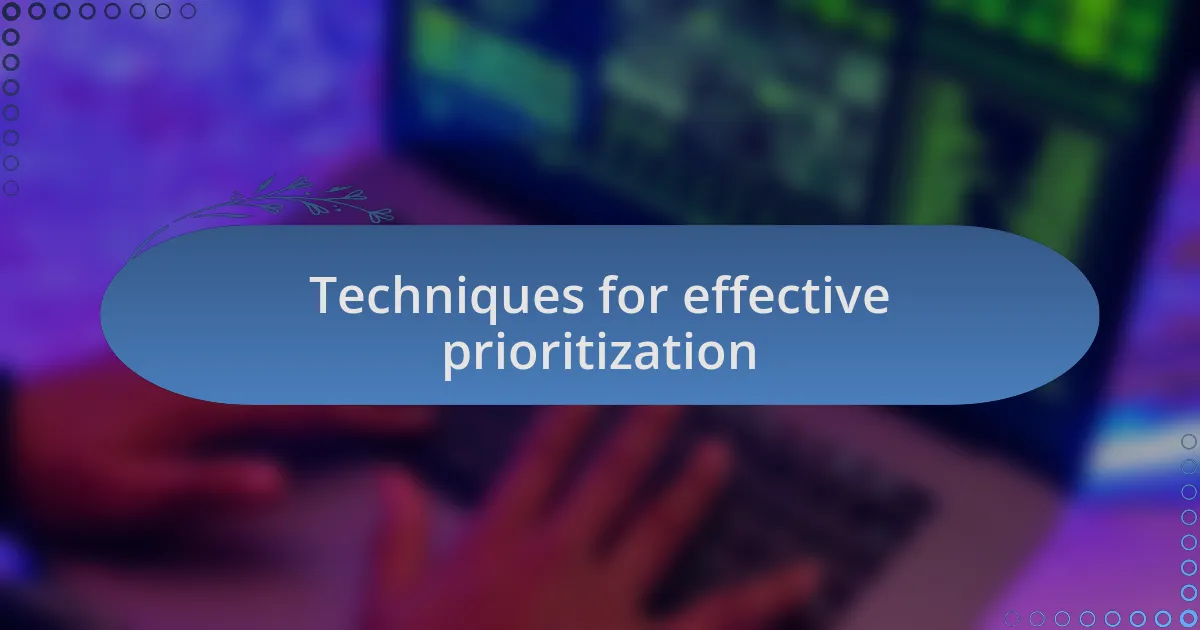
Techniques for effective prioritization
When it comes to effective content prioritization, one technique I’ve found invaluable is creating a content matrix. I remember sitting down with my team to map out our priorities across different categories, such as urgency, impact, and audience interest. This visual tool helped clarify what to tackle first and why, turning a potentially overwhelming process into a manageable plan. Have you ever tried visualizing your tasks? It’s incredible how it can bring focus to your efforts.
Another approach I often use is the 70-20-10 rule. I allocate 70% of my resources to core topics that drive steady traffic, 20% to emerging trends, and 10% to experimental content. I recall a time when I ventured into a new format, like video tutorials, with that 10%. It not only widened my reach but also introduced an exciting dynamic to my content strategy. How do you balance established content with the lure of experimentation?
Lastly, I believe in implementing regular content audits. Periodically reviewing what resonates with readers allows me to spot gaps and opportunities. There was a moment last year when my audit revealed that older posts were consistently earning traffic months after publishing. It inspired me to refresh those pieces, adding new insights that sparked renewed interest. Isn’t it amazing how looking back can illuminate paths forward? By evaluating past performance, I can ensure that my prioritization process remains fluid and responsive to my audience’s needs.
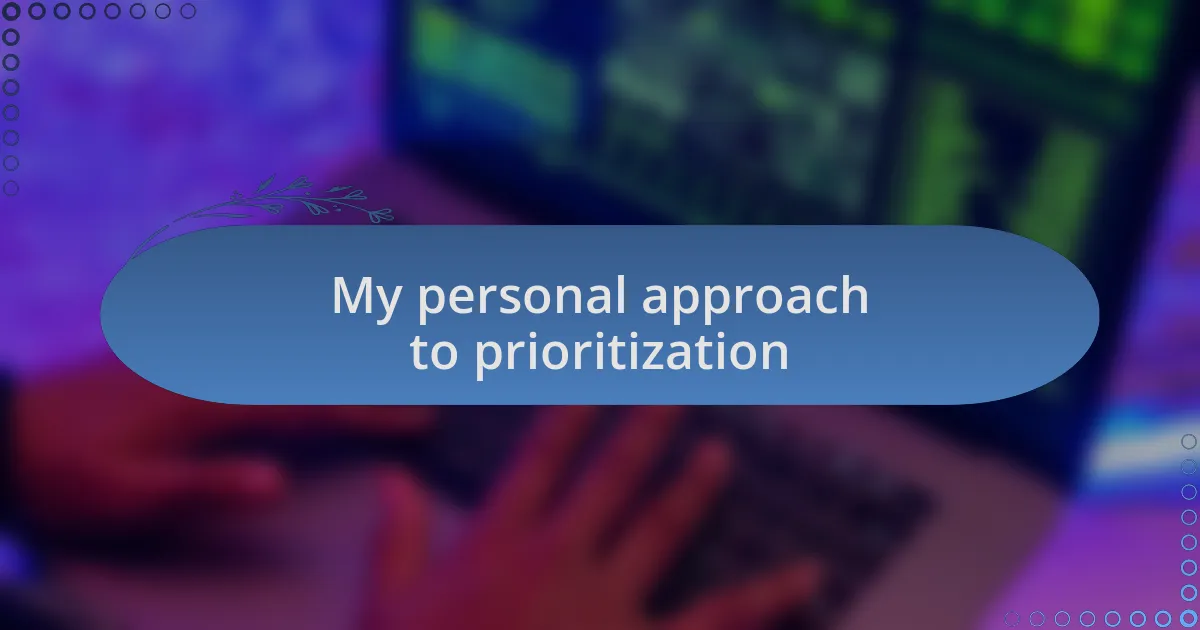
My personal approach to prioritization
My personal approach to prioritization often hinges on understanding the specific needs of my audience. Recently, I found myself reflecting on a project where I researched user feedback diligently. It struck me how much clarity this brought. By focusing directly on what my audience craved, I was able to prioritize topics that not only resonated with them but also strengthened my relationship with those readers. Isn’t it rewarding to craft content that speaks directly to someone’s needs?
I also value flexibility in my prioritization process. There was a time when I planned content six months out, only to realize half of it was outdated by the time it was slated for publication. Now, I maintain a more agile stance, regularly revisiting and adjusting my priorities based on real-time data and trends. This adaptability turns potential roadblocks into opportunities. Have you ever found that making room for change can lead to unexpectedly successful outcomes?
Lastly, I deeply believe in the power of collaborative brainstorming. I often gather my team for informal brainstorming sessions where everyone shares their thoughts and insights. The excitement in those discussions often leads to a prioritization of ideas that I alone may not have considered. I recall a particularly vibrant session where an offhand remark inspired an entire content series. Isn’t it fascinating how collaboration can amplify our individual approaches to prioritization?
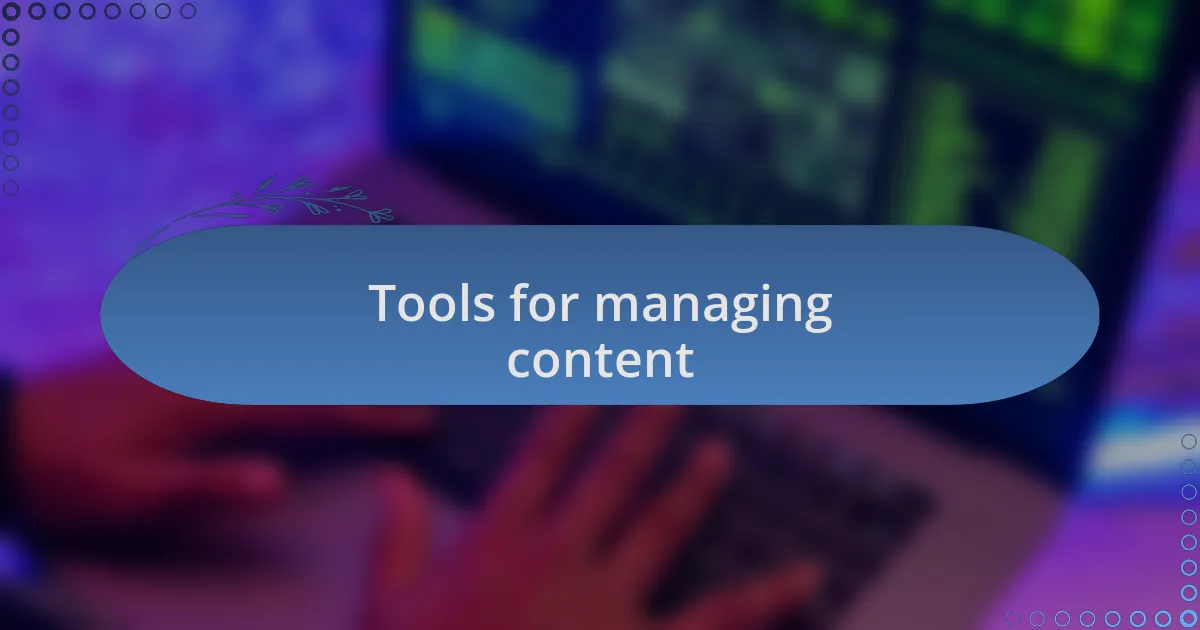
Tools for managing content
Effective content management relies heavily on the right tools to streamline the process. For instance, I’ve found that using Trello has transformed the way I organize tasks and collaborate with my team. With its card and board system, I can visualize our progress at a glance, making it easier to prioritize tasks based on urgency and importance. Have you ever experienced a project where a simple tool changed the entire workflow?
Another tool that I swear by is Google Analytics. It provides invaluable insights into user behavior, allowing me to see which content resonates well with my audience. With that data, I can shift my focus toward topics that generate more engagement. I remember a project where digging into these analytics led me to uncover hidden gems—articles that surprisingly captured attention and traffic, which I hadn’t prioritized. Isn’t it rewarding to let data guide your creative instincts?
Lastly, I’ve recently begun experimenting with Notion for content planning. Its flexible interface empowers me to create databases that combine editorial calendars with rich content ideas. This adaptability has enhanced my creative flow, enabling me to pivot quickly when new trends emerge. I still recall the excitement of drafting a piece based on a sudden industry shift, which became one of my most popular articles. How do you think flexibility in your toolset might influence your content strategy?
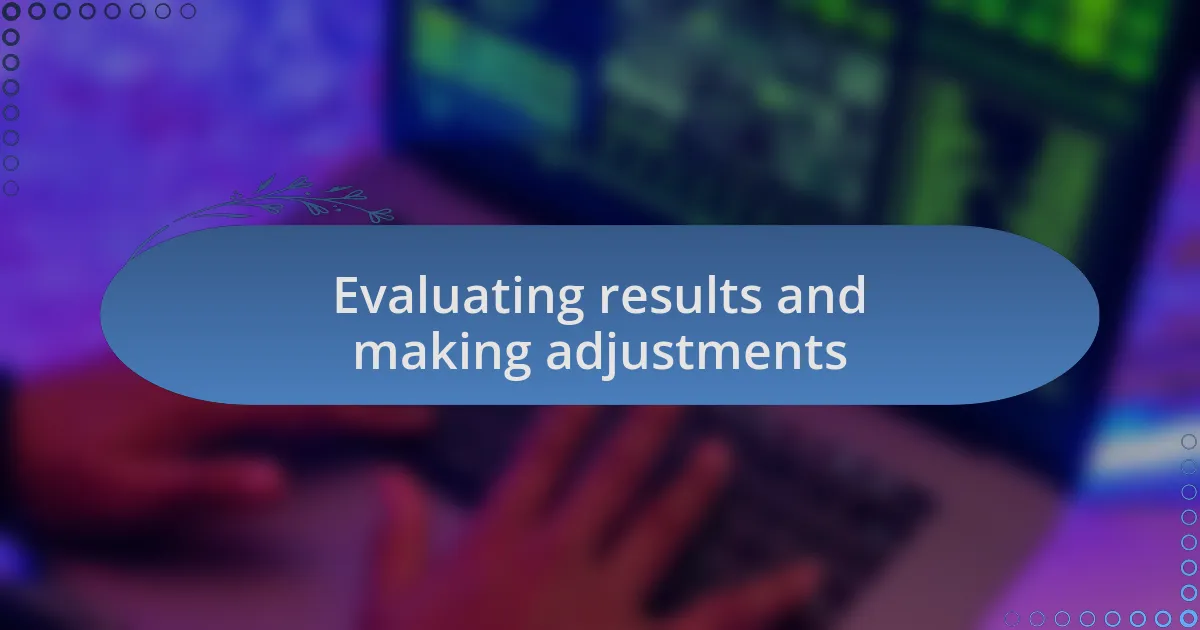
Evaluating results and making adjustments
Evaluating the results of my content efforts is where the real magic happens. I often dive deep into performance metrics, scrutinizing every detail like a detective solving a case. There are moments when I uncover surprises—like finding out that a piece I spent hours perfecting didn’t resonate, while another, hastily written, garnered significant traffic. It’s those unexpected insights that truly inform my next steps.
I’ve learned to adjust my approach based on data rather than assumptions. For example, after launching a recent campaign, I noticed a dip in engagement on certain articles. That prompted me to rethink my headlines and calls to action, leading to significant improvements. I remember feeling a mix of frustration and excitement when seeing those analytics shift positively after making even small changes. Have you ever experienced that rush of seeing your adjustments pay off?
Furthermore, I look for patterns in user feedback and interaction. Sometimes, a comment from a reader can highlight an area for expansion or clarity that I hadn’t considered. I find it enriching to create a dialogue with my audience and adapt my content accordingly. How often do you look at feedback to fine-tune your content? That continuous loop of evaluation and adjustment not only enhances my website’s value but also deepens my connection with my audience.